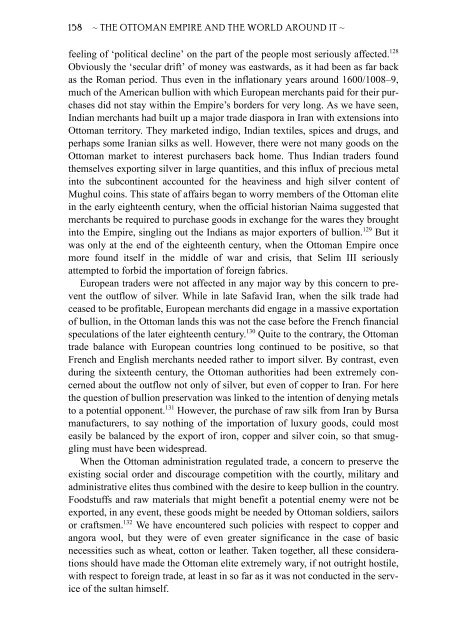The Ottoman Empire and the World Around It - Course Information
The Ottoman Empire and the World Around It - Course Information
The Ottoman Empire and the World Around It - Course Information
Create successful ePaper yourself
Turn your PDF publications into a flip-book with our unique Google optimized e-Paper software.
158 ~ THE OTTOMAN EMPIRE AND THE WORLD AROUND IT ~<br />
feeling of ‘political decline’ on <strong>the</strong> part of <strong>the</strong> people most seriously affected. 128<br />
Obviously <strong>the</strong> ‘secular drift’ of money was eastwards, as it had been as far back<br />
as <strong>the</strong> Roman period. Thus even in <strong>the</strong> inflationary years around 1600/1008–9,<br />
much of <strong>the</strong> American bullion with which European merchants paid for <strong>the</strong>ir purchases<br />
did not stay within <strong>the</strong> <strong>Empire</strong>’s borders for very long. As we have seen,<br />
Indian merchants had built up a major trade diaspora in Iran with extensions into<br />
<strong>Ottoman</strong> territory. <strong>The</strong>y marketed indigo, Indian textiles, spices <strong>and</strong> drugs, <strong>and</strong><br />
perhaps some Iranian silks as well. However, <strong>the</strong>re were not many goods on <strong>the</strong><br />
<strong>Ottoman</strong> market to interest purchasers back home. Thus Indian traders found<br />
<strong>the</strong>mselves exporting silver in large quantities, <strong>and</strong> this influx of precious metal<br />
into <strong>the</strong> subcontinent accounted for <strong>the</strong> heaviness <strong>and</strong> high silver content of<br />
Mughul coins. This state of affairs began to worry members of <strong>the</strong> <strong>Ottoman</strong> elite<br />
in <strong>the</strong> early eighteenth century, when <strong>the</strong> official historian Naima suggested that<br />
merchants be required to purchase goods in exchange for <strong>the</strong> wares <strong>the</strong>y brought<br />
into <strong>the</strong> <strong>Empire</strong>, singling out <strong>the</strong> Indians as major exporters of bullion. 129 But it<br />
was only at <strong>the</strong> end of <strong>the</strong> eighteenth century, when <strong>the</strong> <strong>Ottoman</strong> <strong>Empire</strong> once<br />
more found itself in <strong>the</strong> middle of war <strong>and</strong> crisis, that Selim III seriously<br />
attempted to forbid <strong>the</strong> importation of foreign fabrics.<br />
European traders were not affected in any major way by this concern to prevent<br />
<strong>the</strong> outflow of silver. While in late Safavid Iran, when <strong>the</strong> silk trade had<br />
ceased to be profitable, European merchants did engage in a massive exportation<br />
of bullion, in <strong>the</strong> <strong>Ottoman</strong> l<strong>and</strong>s this was not <strong>the</strong> case before <strong>the</strong> French financial<br />
speculations of <strong>the</strong> later eighteenth century. 130 Quite to <strong>the</strong> contrary, <strong>the</strong> <strong>Ottoman</strong><br />
trade balance with European countries long continued to be positive, so that<br />
French <strong>and</strong> English merchants needed ra<strong>the</strong>r to import silver. By contrast, even<br />
during <strong>the</strong> sixteenth century, <strong>the</strong> <strong>Ottoman</strong> authorities had been extremely concerned<br />
about <strong>the</strong> outflow not only of silver, but even of copper to Iran. For here<br />
<strong>the</strong> question of bullion preservation was linked to <strong>the</strong> intention of denying metals<br />
to a potential opponent. 131 However, <strong>the</strong> purchase of raw silk from Iran by Bursa<br />
manufacturers, to say nothing of <strong>the</strong> importation of luxury goods, could most<br />
easily be balanced by <strong>the</strong> export of iron, copper <strong>and</strong> silver coin, so that smuggling<br />
must have been widespread.<br />
When <strong>the</strong> <strong>Ottoman</strong> administration regulated trade, a concern to preserve <strong>the</strong><br />
existing social order <strong>and</strong> discourage competition with <strong>the</strong> courtly, military <strong>and</strong><br />
administrative elites thus combined with <strong>the</strong> desire to keep bullion in <strong>the</strong> country.<br />
Foodstuffs <strong>and</strong> raw materials that might benefit a potential enemy were not be<br />
exported, in any event, <strong>the</strong>se goods might be needed by <strong>Ottoman</strong> soldiers, sailors<br />
or craftsmen. 132 We have encountered such policies with respect to copper <strong>and</strong><br />
angora wool, but <strong>the</strong>y were of even greater significance in <strong>the</strong> case of basic<br />
necessities such as wheat, cotton or lea<strong>the</strong>r. Taken toge<strong>the</strong>r, all <strong>the</strong>se considerations<br />
should have made <strong>the</strong> <strong>Ottoman</strong> elite extremely wary, if not outright hostile,<br />
with respect to foreign trade, at least in so far as it was not conducted in <strong>the</strong> service<br />
of <strong>the</strong> sultan himself.


